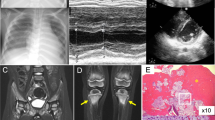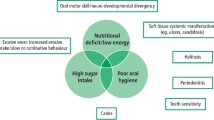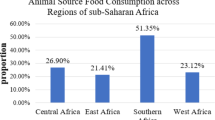Abstract
Scurvy, considered an ancient disease, is now being seen in children with restricted nutritional intake. Often children have vague symptoms which warrant thorough investigations to rule out more serious causes. The diagnostic uncertainty, extensive investigations and prolonged hospitalization has significant impact on child’s development. We have presented a case of scurvy in a 7-year-old boy, known to have ARFID with progressive lower limb pain, weakness, limp and inability to bear weight for 5 weeks which have previously been reported in literature. However, this case was complicated by variable neurological findings during his admission. Scurvy was considered and diagnosed much later in the disease course after ruling out more sinister causes. Main learning points of this case were to have a high index of suspicion for Scurvy in children with restricted intake, and to improve surveillance and monitoring for nutritional deficiencies in these patients.
This is a preview of subscription content, access via your institution
Access options
Subscribe to this journal
Receive 12 print issues and online access
$259.00 per year
only $21.58 per issue
Buy this article
- Purchase on SpringerLink
- Instant access to full article PDF
Prices may be subject to local taxes which are calculated during checkout


Similar content being viewed by others
References
Hahn T, Adams W, Williams K. Is vitamin C enough? A case report of scurvy in a five-year-old girl and review of the literature. BMC Pediatr [Internet]. 2019;19. Available from: https://doi.org/10.1186/s12887-019-1437-3.
Ceglie G, Macchiarulo G, Marchili MR, Marchesi A, Rotondi Aufiero L, Di Camillo C, et al. Scurvy: still a threat in the well-fed first world?. Arch Dis Child [Internet]. 2019;104:381–3. https://adc.bmj.com/content/104/4/381.
Diab Shehade K, Lamdan R, Aharoni D, Yeshayahu Y. “What can you C in a limping child?” Scurvy in an otherwise healthy “picky eater”. Nutrition [Internet]. 2020;82:111019. https://doi.org/10.1016/j.nut.2020.111019.
Gallizzi R, Valenzise M, Passanisi S, Pajno GB, De Luca F, Zirilli G. Scurvy may occur even in children with no underlying risk factors: a case report. J Med Case Rep [Internet]. 2020;14. Available from: https://doi.org/10.1186/s13256-020-2341-z.
Alten ED, Chaturvedi A, Cullimore M, Fallon AA, Habben L, Hughes I, et al. No longer a historical ailment: two cases of childhood scurvy with recommendations for bone health providers. Osteoporos Int [Internet]. 2020;31:1001–5. https://doi.org/10.1007/s00198-019-05264-4.
Gupta N, Toteja N, Sasidharan R, Singh K. Childhood scurvy: a nearly extinct disease posing a new diagnostic challenge, a case report. J Trop Pediatr [Internet]. 2020;66:231–3. https://academic.oup.com/tropej/article/66/2/231/5554622.
Algahtani HA, Abdu AP, Khojah IM, Al-Khathaami AM. Inability to walk due to scurvy: a forgotten disease. Ann Saudi Med [Internet]. 2010;30:325–8. https://doi.org/10.4103/0256-4947.65266.
Boulter EL, Rogers JR, Borland ML. Improving junior doctors’ confidence in paediatric musculoskeletal assessment. J Paediatr Child Health [Internet]. 2014;50:787–90. https://doi.org/10.1111/jpc.12644.
Thibodeau R, Sciacca F, Kirby A, et al. Hypovitaminosis C (scurvy) [Internet]. Radiopaedia.org. 2024 [cited 2025 Jan 13]. Available from: https://radiopaedia.org/articles/hypovitaminosis-c-scurvy-1?lang=gb.
Lykkesfeldt J. On the effect of vitamin C intake on human health: How to (mis)interprete the clinical evidence. Redox Biol. 2020;34:101532. https://doi.org/10.1016/j.redox.2020.101532.
Author information
Authors and Affiliations
Contributions
AAQ wrote the summary of the case and compiled the final report. MS developed the discussion and sourced references. MA editorialised the content and provided submission guidance. LR provided the attached images as well as radiological opinions. SM provided necessary rheumatological insight and ensured medical accuracy of the content.
Corresponding author
Ethics declarations
Competing interests
The authors declare no competing interests.
Additional information
Publisher’s note Springer Nature remains neutral with regard to jurisdictional claims in published maps and institutional affiliations.
Rights and permissions
Springer Nature or its licensor (e.g. a society or other partner) holds exclusive rights to this article under a publishing agreement with the author(s) or other rightsholder(s); author self-archiving of the accepted manuscript version of this article is solely governed by the terms of such publishing agreement and applicable law.
About this article
Cite this article
Qaiyum, A.A., Salim, M., Abdelrehiem, M. et al. ARFID and a twist of lime- unravelling a case of paediatric scurvy. Eur J Clin Nutr 79, 937–939 (2025). https://doi.org/10.1038/s41430-025-01634-w
Received:
Revised:
Accepted:
Published:
Issue date:
DOI: https://doi.org/10.1038/s41430-025-01634-w



